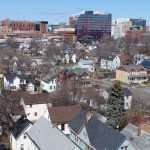
“How Do We Get More Power?”
Faced with an existential threat from the forces of gentrification, residents of Buffalo’s historic African American Fruit Belt neighborhood organized, joined together, and took control of their destiny.
Read the full article from Open Society Foundations, here.
India Walton signed the lease: $1,200 a month for a modest, gut-renovated one-bedroom, $200 less than the listed price because she had her own appliances. Still, says Walton, “in this neighborhood? $1,200 was unheard of.”
At least it used to be. After decades of disinvestment and neglect, the Fruit Belt was beginning to boom.
The catalyst was right next door: a rapidly expanding medical complex, staffed by a growing number of doctors, nurses, and technicians looking for a nearby place to live.
In many ways, it was a familiar story: an African American neighborhood, long neglected by the city, suddenly deemed “desirable” and, in turn, overrun by new, more expensive development. But the story of the Fruit Belt, so named for the orchards planted there in the 1800s [PDF], went in an unexpected direction. As the medical campus grew, the small, sloping neighborhood sitting in its shadow—whose black population boomed following World War II—decided that its fate had not yet been sealed.
